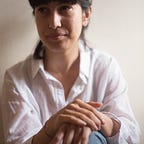On the outskirts of Bangalore, India, tucked in the campus of two government-run schools, is a modest cement structure filled with colorful illustrations and children of all ages. It’s here that you will find the Gubbachi Learning Community, which caters to the children of migrant workers who have fallen through the cracks of India’s public education system.
According to a 2014 UNICEF study, 7.8 million children in India are out of primary school. Somya Nand, one of Gubbachi’s founders, says the actual numbers are even higher. Many out-of-school kids are the children of migrant workers, who often travel to fast-growing metros like Bangalore in search of employment. Some hail from small towns with limited industry, and others from areas that are prone to flooding or drought.
The construction sector is India’s largest employer of migrant labor, with living and working conditions that are abysmal and often dangerous. Most laborers don’t speak the local language, much less know how to navigate Bangalore’s educational system, and employers rarely assist with finding suitable schools for the children. Of the lucky children who do manage to get into schools, over 60% drop out before reaching 13 years of age.
In response, Gubbachi has designed a program that is flexible and responds to the learning needs of migrant children. For instance, they have identified that many students lack basic knowledge of addition, subtraction, and reading. The program’s priority is to bridge these gaps so students can eventually streamline into government-run schools with children their age.
Gubbachi means sparrow in Kannada, the official language in Bangalore. Once a common sight around the city, these birds have almost completely vanished and their absence has gone largely unnoticed. Like these birds, migrant children remain invisible on the fringes of society. All they need, say Gubbachi Learning Community’s founders, is space to flourish.
The program currently enrolls a total of 133 children and is divided into Gubbachi Connect, for children between 2 and 6 years, and Gubbachi Proactive, for children ages 7 to 15. With the younger children, the program aims to integrate them into public school within a year. For the older ones, the program runs longer and is more personalized, with the ultimate hope that students are equipped to sit for their class 10 board examinations.
Inspired by the Montessori educational method, which prioritizes hands-on learning and collaborative play, the Gubbachi Learning Community is designed for children to follow a learning trajectory at their own pace. The curriculum is designed for small groups of children, no bigger than 13. In these small classrooms, children participate in activities like songs, stories, and neighborhood walks, with the aim of strengthening vocabulary and mathematical skills. A large part of the learning process is self-driven with student facilitators, who work closely with them for motivation and confidence building.
According to the founders, in the three years that the program has been operational, most Gubbachi students have successfully integrated into the local school, which has now doubled in size. While these early results are encouraging, the program is still in its nascent stages. Especially given how teacher-intensive Gubbachi is, and how Indian public schools face perpetual teacher shortages, it is too early to tell whether it can be sustained or scaled up throughout Bangalore.
 OOn my visit last week, I joined in on “circle time” with the kids at the early childcare center. I sat next to Hanumesha, aged 4, who had arrived at Gubbachi’s doorstep two years ago with his three older siblings. The children learned about Gubbachi at a community outreach drive and showed up because they wanted to start school. Since then, all of Hanumesha’s siblings have graduated from Gubbachi and have been mainstreamed into the local school. Hanumesha, bright and confident and singing loudly next to me, is on track to join them.
OOn my visit last week, I joined in on “circle time” with the kids at the early childcare center. I sat next to Hanumesha, aged 4, who had arrived at Gubbachi’s doorstep two years ago with his three older siblings. The children learned about Gubbachi at a community outreach drive and showed up because they wanted to start school. Since then, all of Hanumesha’s siblings have graduated from Gubbachi and have been mainstreamed into the local school. Hanumesha, bright and confident and singing loudly next to me, is on track to join them.
After lunch, the children have a short break before classes restart and they’re out playing on the field. The bell rings and they trudge back inside, looking like they haven’t had enough play. There are about 15 children in the class, and they all come from a community of migrant workers from the neighboring state of Andhra Pradesh. They live together in a temporary camp built by their parents, surrounded by tall apartment buildings, also built by their parents. These children are growing up together like an extended family — and it shows. We all sit down in a circle to do an exercise I’ve devised for them. One by one each child talks about what or who they want to become as adults. Then we go to a screen I’ve set up in a corner and I take a picture.
Somya Nand, one of the founders of Gubbachi, tells me she hopes the program will one day not be needed as an intervention, that the educational needs of all children will be be addressed by the state. But until then, she will continue to grow the organization, which is currently funded by Indian foundations and individual donors. Mid-day meals are provided by the government.
Nand’s plan at the moment is to partner with more schools, so the Gubbachi method can become more accessible to children of migrant laborers. “The key is to start early, at the primary level,” she says, to “instill a sense of curiosity and confidence.”
